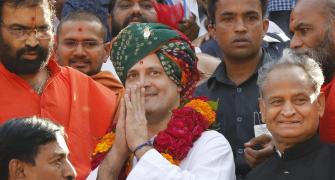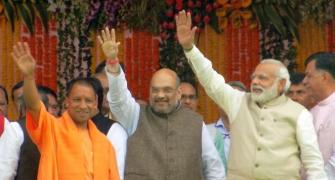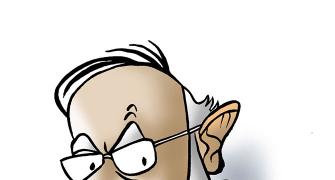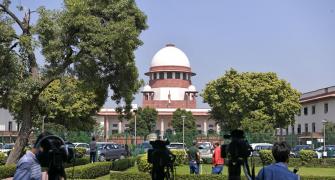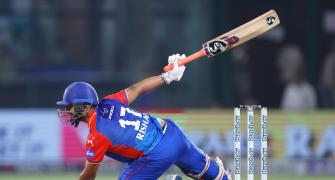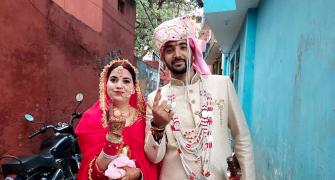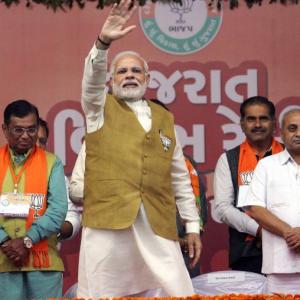'Unlike in Gujarat, where he could ask for votes based on delivery, in 2019 he will have to appeal to his core Hindutva ideology, by firing over someone else's shoulders,' says T C A Srinivasa-Raghavan.

IMAGE: Prime Minister Narendra D Modi in Lucknow on Dussera, 2016.
India's prime ministers are a fascinating bunch.
All of them have had to strike a balance between political and governance instrumentality and ideology. Viewed from that perspective, we get a very consistent set of PMs.
The sole exception, perhaps, was Indira Gandhi, for whom self, family and party, came in that order.
The country was an also ran.
Ideologies, if you think about it, come in three sizes: Large, Medium, and Small.
If we were to categorise parties along these lines, the Communists are L, the BJP is M, and the Congress is S.
The regional parties, which are an important part of India's politics now, have no ideology whatsoever and have only one instrument at their disposal, their Big Chiefs -- Karunanidhi, Jayalalithaa, Mayawati, Lalu, Nitish, Mulayam, Chandrashekhar Rao, Chandrababu Naidu, the Abdullahs, the Muftis et al who, in turn, have just one instrument which is used solely for winning elections: Caste or religion or chauvinism.
In their priorities governance is an also ran.
The BJD of Odisha is the exception which perhaps proves this general rule. It has a Big Chief who uses a variety of instruments very deftly to govern and thus remains in power.
The remaining Big Cs, because they know how to win in elections but not govern, don't stay in power for more than one term.
Mamata Banerjee is none of the above. Her main instrument is populism.
The TMC is what the CPM was -- covertly communal and openly anti-industry. It is the mirror image of the CPI-M minus any ideology.
Fortunately, none of these parties has any chance of forming a government at the Centre.
That leaves the Big Two, the BJP and the Congress. They are big electorally, of course, but also because of the mind space they occupy. But the contrast between them can be stark or negligible.
Much of this contrast depends on their leaders. The Congress, when in power, focuses only on political instruments —- the Family, MGNREGA, etc.
Depending on the circumstances it does what is needed, sometimes successfully and sometimes not.
Consistent with this approach, Rahul Gandhi is now trying to be a card-carrying Hindu.
If you ask him 'kya chal raha hai', he will say 'Hindutva chal raha hai'.
His father, Rajiv Gandhi, too, had tried something similar in 1989, when he allowed the shilanyas at Ayodhya. It backfired.
Sonia Gandhi, however, has adopted the mother-in-law model -- prima la famiglia. Like Indira Gandhi, she sees no contradiction between hereditary rule and inner-party democracy.
P V Narasimha Rao was a soft Hindutva man. He had strong Hindu roots and was a scholar whose priorities were the opposite of Indira Gandhi: Country first and then party. No family.
Try whatever works, including an understanding with the BJP that the two would cooperate in the national interest. He did well in governance and badly in elections.
Atal Bihari Vajpayee was a clone of Narasimha Rao. Intellectually, it is impossible to tell them apart.
For him, too, it was country first and then party. No family for him either, nor ideology. Just try whatever works. He also lost the election after a full term.
Manmohan Singh was prime minister continuously longer than all his predecessors except Nehru and Indira Gandhi.
His priorities were the Gandhi family, himself, country, and, only finally, party.
For him family and party were the same -- with reversibility implications.
Where does Narendra D Modi fit into this ideology-instrumentality framework?
The answer lies in his Gujarat model, which was an 'identify-and-fix-the-problem' method, namely, people will vote for you if you give them what they need.
The PMO has been doing just this since 2014. You can see this from the lists that his ministries put out from time to time.
It is, if you will, a highly effective -- but municipal -- approach to running a country.
But there is a problem: The Centre's main job is to devise policies, not look for governance fixes all the time.
That is what the state governments have to do which they are not because the Centre is doing it.
Mr Modi focuses so much on instrumentalities -- try this, and if it doesn't work, try that -- that his government seems to be constantly flip-flopping between what it calls policies. This list is also quite long.
The result is that unlike in Gujarat, where he could ask for votes based on delivery, in 2019 he will have to appeal to his core Hindutva ideology, albeit by firing over someone else's shoulders.
It will be interesting to see if it works.


